This is a guest blog by Ben Clark that I am happy to reproduce here.

Ben Clark on 24,688' Annapurna IV's North Ridge. Clark and Josh Butson were the first to lay ski tracks on this notoriously unstable route. Photo credit: Josh Butson
Carving one last wet, heavy mid afternoon turn into camp last May, I stopped, clicked out of my ski bindings and took a step back from 10 years of working alpine routes in the Himalayas. I began this 10-year career with an Everest summit on my second expedition and then attempted 13 more peaks in the Himalayas. My partners and I would dispatch routes in a bold style that, depending on whether you read the NY Times or the Adventure Journal, either brought us closer to death or closer to life in this humbling and crushing mountain range. I have a biased assessment on the position of life or death. I made it through physically unscathed and can reflect on experiences “in the field” with great partners, good memories and only “some” bad luck. But a lot of my friends, and some of my mentors did not fare as well: some died, some quit, others didn’t know when to stop. It is with that disclosure that I begin to wax sublime on some of my more memorable moments and a couple of caveats to explore if you think this is an interesting topic:
1. All I wanted to do was see the world. From the age of 20 until 32 that manifested into mountaineering and channeling all my efforts, extra money and time into the Himalayas.
2. This was not a hobby for me. It was an obsession that drove almost every decision I made during that time. It had to or I would not have survived what I was doing. No mountain was worth giving up the chance to explore another one for, so I had rules that I followed and when I committed to climbing a peak, made it happen despite a real job.
3. I love this sport whole-heartedly and it makes me hurt deep down in the pit of my stomach when I think about never doing it again. But not as bad as the thought of making a fatal mistake and hurting the people I love.
So here you go, a snapshot of what I have to contribute on life, death, risk… and why I personally chose to take time this year to consider what I was doing.
It was a chilly October and my right butt cheek was smeared against a frigid corner of bare granite, knee grinding into the opposing wall over a single toothy crampon point that held my weight while a heel sloped downward and my achilles fought for reprieve. In this precarious position 90′ above Josh, my partner on the wall and belayer, I had a left leg flagged out into space pressing away from the corner. It was desperate, my quivering right arm clutched an ice tool hooking an 1/8″ nub of bare rock while my left arm extended into a steel pick scratching a surface of thin decomposing snow and ice. In the still air at 17,000′ I yelled down to Josh to untie from the rope between us, “Josh, take me off!” He responded: “What???” I repeated what I knew he had to do: “Take me off, I will kill us both if I fall.” At that moment, severely exposed and wildly wrong about adequate protection (I had placed none) in the vertical corner I was inching upward in, “26 year old me” knew if I made one error I would die from a fatal 1200′ fall and violently rip Josh off as well, the two of us tumbling to death six days from a road that led to a town where people spoke only Mandarin, in a Chinese valley where no one knew we were. This was difficult terrain to be soloing but I knew I could execute the moves to safety because I never allowed my emotions free reign to seize and paralyze me in the moments where my life, death and the future was suspended in balance like this. I had nothing to lose, which helped. After all, I would leave nothing behind but about $700 in my bank account, no debt and an e-mail to my parents from a smoky bar in Rilong — a forgotten relic of a town in the far Eastern Himalaya that crumbled in an earthquake in .
But I didn’t fall that day in 2006. And we still had an epic time getting off that mountain in the dark, in a major storm with two ropes and barely any protection for adequate anchors in the featureless compact granite. We took risk and we executed, death was an option, just never acceptable for us. But I want to phrase that carefully; I did not see this as cheating death, I was cheating odds, which is a different game and mindset. Even though I love nature and alpine environments, luck was the most prevalent explanation for living and also the most seductive element of adventure granting clouds and snow, sun and summits and fate or failure. When we got home to Telluride, Co. from that trip, all I wanted to do was have a conversation with my local mentors Charlie Fowler and Chris Boskoff about how awesome the trip had been, how confident I now felt putting up a new route in the Himalayas. They too were in China on an expedition, but they never came home, an avalanche swept over them a few weeks after the storm we had survived. They died doing what they loved.

Jon Miller belays Josh Butson as the team reached the site of a 5 night stay at 21,600' in a fierce Himalayan maelstrom on Baruntse. Photo credit: Ben Clark
In , with three more aggressive years to hone my experience and an appetite for dangerous runouts, I was in the lead on a new route on the NE face of 23,390′ Baruntse in the Nepali Himalayas. Josh, Jon and I had committed to what we thought was a six-day alpine style push with the bare amount of equipment to climb the mountain by a new route, summit and then ski down the other side. This was my dream climb and the route I would say had the most influence on me than any other route I ever touched. I wanted to traverse it more than any ground on earth. But on that day as I led, ice climbing on a shiny spine of ice cleaving a wide open face capped by dangerous icefall on either side, I peered across valley to the 8000′ south face of 27,940′ Lhotse to watch the jet stream explode against it in a 3000′ tall mushroom cloud framed by an eerie alpenglow. I scarily uttered through chattering lips with 2000′ of air nipping at my heels: “Living people do not see things like this.” That night, on a ledge we chopped out and sat on for five days, I hunched over with my frost nipped feet warming on Jon’s stomach holding his hands so he could lean forward and puke into a Ziploc bag. Josh melted water in a stove almost hanging in space on the edge of the tent. We settled into an uneasy realization of what we all knew may be true — this could be it if the storm built steam and blew our tent to pieces. We had reached a point of too far, not yet no return, and would have nothing but time to worry about our fate as Jon’s stomach ailment deteriorated into a serious condition.

21,600' camp on the NE face of Baruntse, aka "the good times clubhouse." Josh Butson, Jon Miller and Ben Clark spent five nights here in a storm that everyone down below thought killed them.
But the storm built only so much steam and we lived. After 10 days on the mountain we rappelled the route rescuing Jon and in three months I was in Salt Lake City, Utah at the Outdoor Retailer show talking to an athlete manager of a company that supported me as an athlete. Recounting this tale and then discussing the fate of a new friend I had made that year who had reached out to me for advice before my trip — Micah Dash, we remembered Micah’s adventurous spark, which was extinguished with two others by an avalanche in Sichuan while we were on our climb. The last e-mail I got on day six of our approach to Baruntse was about Mt Edgar; “Did I know anything about it?” The news of why he hadn’t responded to my last e-mail hit me just one week after returning home from Baruntse and somehow the stock sentiment made me pale this time. He died doing what he loved.
In May , with my wife at home pregnant with our son, I broke trail in 3′ of snow up a large valley on 21,506′ Chulu West with Jon, Chris and Gavin. We climbed three awkward pitches of rock the day before to get into position to be the first people to ever ski this valley and were hit by a major electrical storm that delayed our start and lay fresh snow over some dangerous terrain up high. At just after noon that day we stood looking at the last steep pitch leading to the summit ridge, the sun was intense, heat was picking up and large chunks of cornices had crashed into the slope and triggered a couple of sizeable avalanches. At that moment, my mind drifted to where it always had, where I knew that there was a good chance that if we set foot on the slope it would avalanche, but I wanted to go anyway because I have tempted fate many more times than just what is above and it has worked out. That is what it takes to make it to the top.
But this time it didn’t work out, we did not “succeed” and tag the summit. We talked about it. We talked ourselves out of it. Why? Because I don’t want to die a suffocating oppressive death after being ripped to pieces and then buried beneath a ton of snow. We would not settle for eight more ski turns and a stale eulogy. I did not want to be someone who “died doing what they loved” because if that were the case, then I would die hanging out with my family, sleeping, eating ice cream, pizza, editing a film, listening to a great song — just sayin’. Luckily, by committee, everyone elected that we should “just ski”… novel right? We didn’t actually have to increase our risk of death to pull that off and have fun. My God, why did it take me so long to learn that? Just skiing there was “extreme” enough and I was so engrossed, so used to laying it out there that I could not even see that was an accomplishment. It had become routine to pioneer, dangerously so.

With occasional views like this, why wouldn't you at least be curious to explore the Himalayan high Country? I snapped this photo right before skiing off the summit of 20,201' Thorung peak.
In 15 peak attempts in the Himalayas from Dhaulagiri in Western Nepal, the summit of Everest in Tibet and the far reaching slopes of The Savage Sister in eastern Sichuan, I had come close or had completely risked it all every time, every time except this one. I have broken an ankle, rescued a friend, run out of oxygen on summit day, been in an avalanche scenario and watched friends fall in crevasses, lose feeling on the right side of their body and cry, cry in the anguish of physical and emotional defeat. I have given up myself in the dark hours of a stormy night and understood the process that leads one to freezing to death alone and undisturbed by that choice. This time everything went right, including my attitude toward it all… so I quit, the moment I finally got “a head.”
Situations and tolerances vary for everyone and across latitudes and longitudes. Education is the best backup to support your judgment when taking risk. There will still be moments after you have gained that medical and snow science knowledge when you are in the mountains and your tolerance will negate what you have learned or the situation will fall outside what you were taught. If you proceed at that time you must knowingly commit and pursue your present goal with little more than faith that the consequences you are anticipating are truly manageable within the system of variables you are engaging with. That is adventure; it is in that space I loved so dearly, where I learned to be present on the line between here and now and tomorrow or never. Don’t forget though, that the system you are engaging is greater than the slopes around you and you may have to speak to someone’s mother, father, wife or brother about the mistake you don’t think you are about to make, even though most of the time you won’t. But if you do, if something goes wrong, if you nearly cost someone his or her life or are there when something out of your control goes completely wrong, I can only tell you that in my experience, it is a far lower low than any altitude high you may ever reach.
Every now and then, it makes sense to press pause. On our iPod, during a movie, in a heated debate… sometimes we just need a break to process all the excitement and the stimulation. There is little room for pause in real life or the types of scenarios above. There is no skill that will comfortably guarantee survival either, for that there is only luck. I think that is why they call it risk and nothing else
. I think that is why I always encourage others to go if that curiosity drives you. Considering what I have survived, I would go forward in some instances where others may have stayed home because I felt it was necessary to explore boundaries. I don’t regret that I did, but I’m not continuing onward today. I have already gone and I have come back. And on this side of things, I am enjoying a state of pause, reflection and peace with my decisions.

"Of course it is worth it"- Ben Clark skiing powder on the North Slopes of 20,201' Thorung peak with 21,506' Chulu West behind him. Photo credit: Hari Mix
More here:
http://www.goduproductions.com/about/crew/


 With my Pashley Princess having transitioned to a new home, it is time to ring in a new era.
With my Pashley Princess having transitioned to a new home, it is time to ring in a new era. This is my new friend, as well as the reason the Pashley has left me: an olderGazelleI unexpectedly acquired last week.
This is my new friend, as well as the reason the Pashley has left me: an olderGazelleI unexpectedly acquired last week. This Gazelle is most likely from the mid-to-late 1990s (which, frightening to think, was 15 years ago!). It was made in Holland, purchased in Germany, and brought to the US some time ago by the previous owner. It feels like a modern bike, but handles similarly to a vintageRaleighDL-1.After riding it for several days, it became clear that it suited me better than either myPashleyor my vintageRaleigh, because it combined my favourite features of both. Thus, thePashleywas set free, and the vintageRaleighwas moved to our photo studio (to replace theMerciermixte, which has been set free as well). The decision was swift and ruthless, as I did not want to dwell on it too much. TheGazelleis not quite as elegant as thePashleyand not as rare as the vintageRaleigh -but as a transportation bicycle it just suits me better.
This Gazelle is most likely from the mid-to-late 1990s (which, frightening to think, was 15 years ago!). It was made in Holland, purchased in Germany, and brought to the US some time ago by the previous owner. It feels like a modern bike, but handles similarly to a vintageRaleighDL-1.After riding it for several days, it became clear that it suited me better than either myPashleyor my vintageRaleigh, because it combined my favourite features of both. Thus, thePashleywas set free, and the vintageRaleighwas moved to our photo studio (to replace theMerciermixte, which has been set free as well). The decision was swift and ruthless, as I did not want to dwell on it too much. TheGazelleis not quite as elegant as thePashleyand not as rare as the vintageRaleigh -but as a transportation bicycle it just suits me better. This Gazelle is the A-Touren model, which I believe is the predecessor of what is now the Toer Populair. It looks similar to the Toer Populair, but comes with a coaster brake (yes!) and front drum brake, whereas the current model has rod-activated brakes.
This Gazelle is the A-Touren model, which I believe is the predecessor of what is now the Toer Populair. It looks similar to the Toer Populair, but comes with a coaster brake (yes!) and front drum brake, whereas the current model has rod-activated brakes.  This bicycle is enormous. The frame is 57cm (22.5") with 28" wheels and wide tires, and I am just barely tall enough to get on and off comfortably. In fact, I had to remove the original saddle (which had monstrously huge springs) and borrow the flatterBrooks B18 from my vintage Raleighin order to ride it.But that is fine with me, as the large frame feels very comfortable.
This bicycle is enormous. The frame is 57cm (22.5") with 28" wheels and wide tires, and I am just barely tall enough to get on and off comfortably. In fact, I had to remove the original saddle (which had monstrously huge springs) and borrow the flatterBrooks B18 from my vintage Raleighin order to ride it.But that is fine with me, as the large frame feels very comfortable. Indeed, the enormousness of the bicycle seems to be an asset while cycling. Riding this Gazelle feels like sailing a ship - a huge and initially unwieldy ship that surprises you with its agility and power to accelerate once it is in motion. It sails through flat stretches and then glides uphillonce you get it going,seemingly on its own accord. To be sure, it is a dauntingly heavy bike - but I do not feel the weight once I am in motion, and it does not pull me backwards when stopped at hill-top intersections.
Indeed, the enormousness of the bicycle seems to be an asset while cycling. Riding this Gazelle feels like sailing a ship - a huge and initially unwieldy ship that surprises you with its agility and power to accelerate once it is in motion. It sails through flat stretches and then glides uphillonce you get it going,seemingly on its own accord. To be sure, it is a dauntingly heavy bike - but I do not feel the weight once I am in motion, and it does not pull me backwards when stopped at hill-top intersections. Everything in the pictures is native to the bicycle, except for the saddle, the pannier, and the coiled cable lock on the rear rack. It has a (Sachs) 3-speed coaster brake hub that works perfectly, and the gearing is just right for me. The front drum brake is activated by a lever mounted on the right handlebar. The headlight and tail light are bottle-dynamo activated. They work nicely, but eventually we might rig up a system to make the headlight brighter. The fenders, full (vinyl) chaincase and solid (vinyl) dressguards are in excellent condition. The rear fender has not only the white edging, but also the matching Spanniga tail light I so love that was specifically designed for these. The rear rack is enormous and sturdy. It is the only part of the bicycle that shows signs of wear - a small patch of rust where some paint got scraped off.
Everything in the pictures is native to the bicycle, except for the saddle, the pannier, and the coiled cable lock on the rear rack. It has a (Sachs) 3-speed coaster brake hub that works perfectly, and the gearing is just right for me. The front drum brake is activated by a lever mounted on the right handlebar. The headlight and tail light are bottle-dynamo activated. They work nicely, but eventually we might rig up a system to make the headlight brighter. The fenders, full (vinyl) chaincase and solid (vinyl) dressguards are in excellent condition. The rear fender has not only the white edging, but also the matching Spanniga tail light I so love that was specifically designed for these. The rear rack is enormous and sturdy. It is the only part of the bicycle that shows signs of wear - a small patch of rust where some paint got scraped off. What I love about older Gazelle bicycles, is the overwhelming amount of proprietary insignia with a gorgeous Art Nouveu feel to it. This is the headbadge.
What I love about older Gazelle bicycles, is the overwhelming amount of proprietary insignia with a gorgeous Art Nouveu feel to it. This is the headbadge. And a tiny badge underneath the tail light. Who does that anymore?
And a tiny badge underneath the tail light. Who does that anymore? Tiny gazelles embossed onto the chrome on the flat fork crown!
Tiny gazelles embossed onto the chrome on the flat fork crown! A gazelle on the front fender!
A gazelle on the front fender! A gazelle on the stem bolt.
A gazelle on the stem bolt. Even a gazelle on the kickstand bolt! And of course you already saw the gazelle on the bell in the first picture.
Even a gazelle on the kickstand bolt! And of course you already saw the gazelle on the bell in the first picture. Another design feature I love about this bicycle, is the lugged connector between the downtube and the curved toptube. Most manufacturers no longer do this, and I do not remember whether the current production Gazelleframes are still made this way. Anybody have one handy to check? It would have to be a post-2006 model, which is when I think they changed production methods.
Another design feature I love about this bicycle, is the lugged connector between the downtube and the curved toptube. Most manufacturers no longer do this, and I do not remember whether the current production Gazelleframes are still made this way. Anybody have one handy to check? It would have to be a post-2006 model, which is when I think they changed production methods. I hope you enjoyed this introduction to my new-to-me bicycle, and I will write more as I get to know her better. I do not see myself making too many adjustments to this bike, other than eventually replacing the tires with cream Schwalbe Delta Cruisers and maybe getting some nicer grips. I don't think the absence of my Pashley has fully sunk in yet, but I am pleased about the home she went to - they are a beautiful match. Hopefully, I have now met my match as well! Now, to think of a name...
I hope you enjoyed this introduction to my new-to-me bicycle, and I will write more as I get to know her better. I do not see myself making too many adjustments to this bike, other than eventually replacing the tires with cream Schwalbe Delta Cruisers and maybe getting some nicer grips. I don't think the absence of my Pashley has fully sunk in yet, but I am pleased about the home she went to - they are a beautiful match. Hopefully, I have now met my match as well! Now, to think of a name...
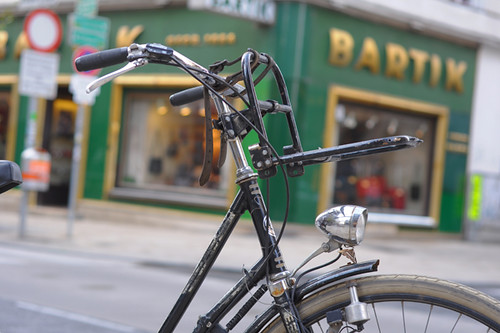 If you've been reading this blog for some time, you are familiar with "Jacqueline" - the vintage Steyr Waffenrad lugged swan-frame bicycle that I ride in Austria. Though she does not belong to me, my friend Wolfgang lends her to me when I am in Vienna. I keep Jacqueline parked outside the flat where I am staying, and use her to get around everywhere.I am very fond of this bicycle and we have not seen each other since last summer, so the reunion was joyful.
If you've been reading this blog for some time, you are familiar with "Jacqueline" - the vintage Steyr Waffenrad lugged swan-frame bicycle that I ride in Austria. Though she does not belong to me, my friend Wolfgang lends her to me when I am in Vienna. I keep Jacqueline parked outside the flat where I am staying, and use her to get around everywhere.I am very fond of this bicycle and we have not seen each other since last summer, so the reunion was joyful.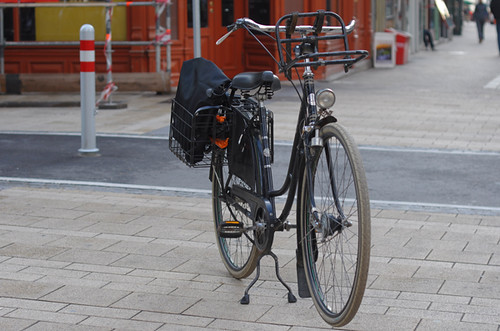 The more other classic city bikes I try, the more I realise just how unusual this one is. It is somewhat similar to a Dutch bike, but with a shorter wheelbase, lower bottom bracket, and a shorter head tube - allowing for the handlebars to be set lower. It is unliftably heavy, but rolls very easily and accelerates well. The fork has an insane rake that would make toe overlap impossible even in size 20 workboots. The steering requires a very light touch, or else the entire front end wobbles. Jacqueline always takes me a few minutes to get used to, but after that she feels incredibly natural. The bike is not effortful to ride long distances, and last summer I took 30 mile trips along the Danube on it easily.
The more other classic city bikes I try, the more I realise just how unusual this one is. It is somewhat similar to a Dutch bike, but with a shorter wheelbase, lower bottom bracket, and a shorter head tube - allowing for the handlebars to be set lower. It is unliftably heavy, but rolls very easily and accelerates well. The fork has an insane rake that would make toe overlap impossible even in size 20 workboots. The steering requires a very light touch, or else the entire front end wobbles. Jacqueline always takes me a few minutes to get used to, but after that she feels incredibly natural. The bike is not effortful to ride long distances, and last summer I took 30 mile trips along the Danube on it easily.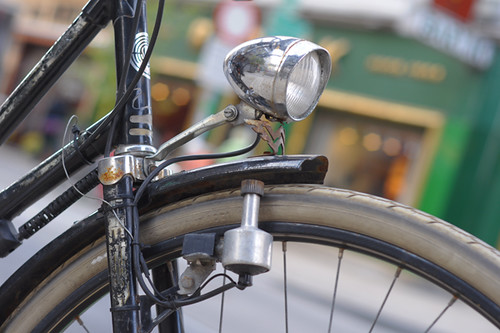 The lighting looks ancient, but works just fine.
The lighting looks ancient, but works just fine.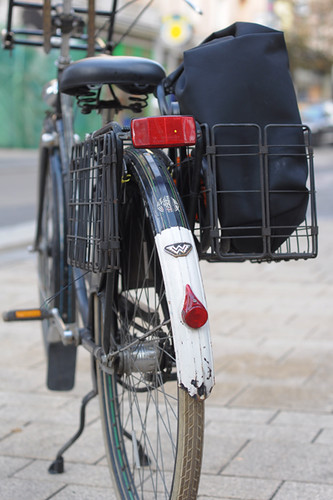 The rear folding baskets work perfectly for carrying my stuff. I feel like I have a system with this bike, and we understand each other. Given how heavy it is, I am not sure that it would work well for me in Boston. But it's perfect for the Vienna infrastructure.
The rear folding baskets work perfectly for carrying my stuff. I feel like I have a system with this bike, and we understand each other. Given how heavy it is, I am not sure that it would work well for me in Boston. But it's perfect for the Vienna infrastructure.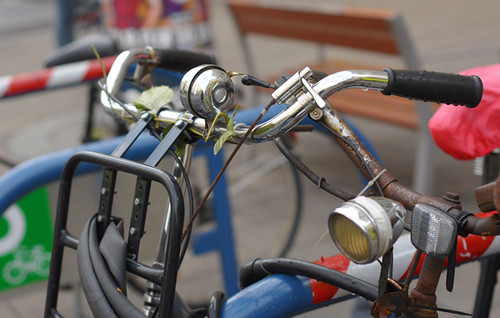 Wolfgang has an extensive collection of old Austrian city bikes, and some of Jacqueline's friends were parked next to her when I came to pick her up. I was in a hurry, but I have my "good camera" with me here this time - so will try to take some decent pictures of Wolfgang's vintage bikes and his other projects. In addition to offering bicycle tours of Vienna, he recently started a company offering moving and delivery services via cargo bikes, and has recently opened up a cargo bike shop that carries nearly every single manufacturer of box bikes and longtails in existence. Hopefully I will be able to test ride a few.
Wolfgang has an extensive collection of old Austrian city bikes, and some of Jacqueline's friends were parked next to her when I came to pick her up. I was in a hurry, but I have my "good camera" with me here this time - so will try to take some decent pictures of Wolfgang's vintage bikes and his other projects. In addition to offering bicycle tours of Vienna, he recently started a company offering moving and delivery services via cargo bikes, and has recently opened up a cargo bike shop that carries nearly every single manufacturer of box bikes and longtails in existence. Hopefully I will be able to test ride a few. As we headed to the National Park today, we stopped at the Visitor Center to grab maps. This truck/RV pulled in next to us. I've seen a lot of different RV's over the years, but this one was the first of its kind.
As we headed to the National Park today, we stopped at the Visitor Center to grab maps. This truck/RV pulled in next to us. I've seen a lot of different RV's over the years, but this one was the first of its kind. Lucky for me, the guys was more than happy to show and tell. This made my day. I love stuff like this!
Lucky for me, the guys was more than happy to show and tell. This made my day. I love stuff like this!
 We pass some unusual RV's heading in the other direction
We pass some unusual RV's heading in the other direction We pass thru the Continental Divide
We pass thru the Continental Divide Our second night we stay over in Rock Springs an interesting little town that is built over miles of underground coal mines.
Our second night we stay over in Rock Springs an interesting little town that is built over miles of underground coal mines. There were a few mining accidents - one claimed 169 lives
There were a few mining accidents - one claimed 169 lives They have a wild horse scenic loop so we took a drive. Views for miles.
They have a wild horse scenic loop so we took a drive. Views for miles. Towards the end we did see a few horses.
Towards the end we did see a few horses. On the road to Flaming Gorge.
On the road to Flaming Gorge.









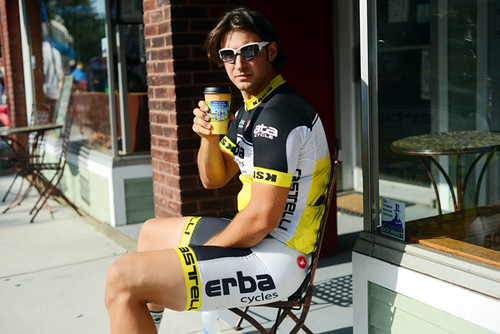
 It's been far too long since I've posted... So what's going on at Mount Rainier? Lots of road repair, but very little climbing and hiking. I snapped this image of the Carbon River Road on Saturday, Jan. 13th. For the most part, hikers/skiers/climbers are limited to the main road corridors, unless they'd like to bushwack.
It's been far too long since I've posted... So what's going on at Mount Rainier? Lots of road repair, but very little climbing and hiking. I snapped this image of the Carbon River Road on Saturday, Jan. 13th. For the most part, hikers/skiers/climbers are limited to the main road corridors, unless they'd like to bushwack.






